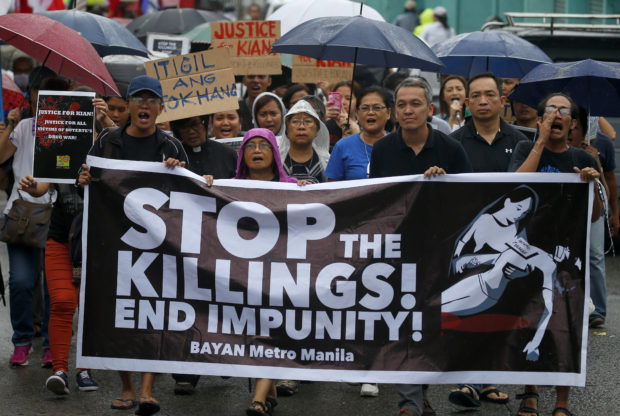Before Kian, there were Danica Mae, Oman, Rowena, etc.

Protesters display a banner as they march to join the wake for slain Kian Loyd Delos Santos, a 17-year-old Grade 11 student, who was killed in a shootout with police five days ago Monday, Aug. 21, 2017 in suburban Caloocan city north of Manila, Philippines. The killing of Kian has sparked protests and condemnation from the public. (AP Photo/Bullit Marquez)
Before the killing of Kian delos Santos, 17, during a police operation in Caloocan City last week, youngsters in Pangasinan province had met violent deaths in President Rodrigo Duterte’s war that’s supposed to rescue them from the drug menace.
Those incidents that left victims as young as Danica Mae Garcia, 5, remain unsolved. She was felled by bullets meant for her grandfather, Maximo, at Barangay Mayombo in Dagupan City, exactly a year ago today. Along with her cousins, she was then preparing to attend her afternoon classes in a nearby public school.
The children were behind the curtain that separated the dining room that also served as a living room from their bathroom, where they were either brushing their teeth or taking a bath.
No CHR assistance
Maximo, seated on a wooden bed, managed to escape. He was on the police list of suspected drug pushers and was supposedly the target of the gunman.
Danica Mae was hit in the head and died in her grandmother’s arms, one of the youngest victims in the drug war.
Article continues after this advertisementThe Commission on Human Rights (CHR) offered financial aid, but nothing has come of it, according to Danica Mae’s grandmother, Gemma.
Article continues after this advertisementBased on police records, 1,269 of 1,364 villages in 43 towns and four cities in the province were drug-affected at the start of Mr. Duterte’s campaign last year.
As of June 15, 1,088 villages, five towns and a city had been declared drug-cleared soon.
The government’s antidrug campaign also resulted in the arrest of 1,577 drug users and pushers.
Thirty-three people were killed when they shot it out with the police. The deaths of 66 others were under investigation, including that of Danica Mae.
Classmates
The unsolved cases include that of Roman Clifford Manaois, 20, and Rowena Tiamson, 22, who were classmates in a university until he transferred to another school. They both dreamed of building a house for their parents.
The two were killed on the night of July 19, 2016, when gunmen went on a rampage, attacking suspected drug users and pushers.
But Manaois and Tiamson were neither addicts nor drug traffickers, their parents, relatives and friends insist. They were at the wrong place at the wrong time, and perhaps, with the wrong company, when hit men killed them.
Oman
Manaois, nicknamed “Oman,” was fetching water when he was asked by John Mark Serrano de Vera, a neighbor, to accompany him to an eatery in Dagupan City to buy “kaleskes,” a kind of soup.
Manaois hopped on the back of the tricycle which De Vera owned. On their way to the eatery, they picked up one Zaldy Abalos.
At 2 a.m. the next day, De Vera’s father rushed to the Manaois’ house in Barangay Carael, crying out, “Go to barangay [Lucao] hall. Oman was shot,” said Dennis, father of Manaois.
“We thought Oman was only hit in the leg,” Dennis recalled, his eyes getting red. But when Dennis and his wife arrived at the barangay hall, they were told to proceed to a morgue where they found their son.
Abalos, the hit men’s apparent target, was also killed, but De Vera was able to run.
The parents of Manaois were at first angry with De Vera whom they blamed for his death until they learned that he, too, was hit, although not fatally.
After the hooded gunmen shot Abalos, they trained their guns on Manaois and De Vera. They started to run when a bullet struck the back of Manaois, piercing his heart. De Vera tried to help Manaois get up but the young man told him to run for his life.
“[Manaois] was a good son,” Dennis said. “He was a big help in the house. He cleaned the house, cooked food. He had no vices at all, let alone drugs.”
Rowena
Graduation did not come for Rowena Tiamson, who was killed also on July 19, 2016. She would have finished her mass communication course at Colegio de Dagupan in October last year. A school choir member, she also sang at two restaurants in the city to earn money.
At 10 a.m., Tiamson headed for school, which was just a walking distance from her house on Arellano Street, according to her mother, Teresita, 57.
“But at 5 p.m., she was not back home yet so I texted her to ask where she was. She said she went with her friends, a girl from Barangay Mayombo and a boy from Manaoag. At 9:40 p.m., I was already worried and called her up. Her telephone rang three times, then there was silence. I could not contact her anymore,” Teresita said.
The next day, the Tiamson family learned of Rowena’s death from a TV newscast.
Teresita said, “The newscaster asked if anybody has a missing daughter who has a tattoo of a musical note on her wrist, as a body of a girl was found in Manaoag.”
The family went there and found Tiamson. Her head was wrapped with packaging tape. Her body bore bullet wounds. A cardboard was strung around her neck with the words: “Don’t emulate, she is a pusher.”
The families of Manaois and Tiamson have realized they would not be able to find justice for the murder of their children, at least, not under the present administration.
“We cannot fight them. Duterte backs the police and the killers, to whom would we turn to?” Teresita asked.